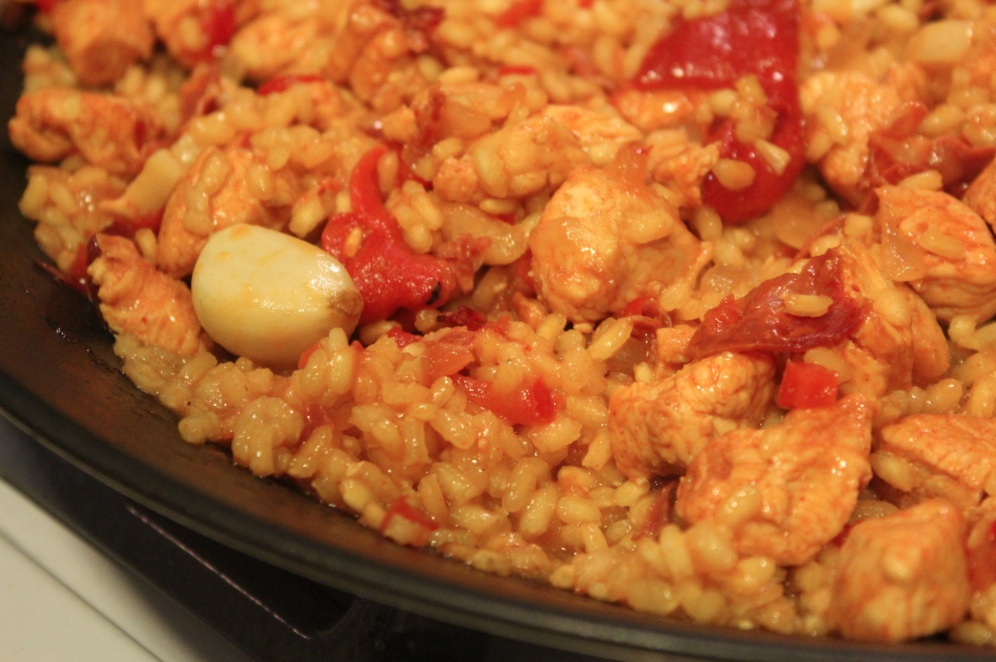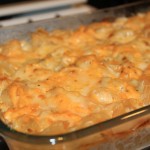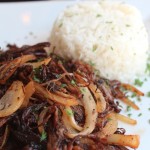Paella Recipe: A Little Taste of Spain in Your Very Own Kitchen
BY: MJ BYERS
“The belly rules the mind.” Spanish Proverb
Dish: Paella with Chicken and Chorizo
I love me some paella. Back when I used to travel to Spain frequently for business, I used to always try to make sure I had it; the folks in my office there were good enough to try to bring it in for lunch. Once these travels began becoming less frequent, I was forced to make due with the often mediocre paellas you find in eateries outside of Spain. So unhappy was I with my restaurant paella options that I figured out how to make my own. Here’s my basic, fairly easy – but super-tasty – recipe. Enjoy!
A few words before we start:
- Seafood: It’s not that I have anything against eating seafood, but it’s a bit easier to prepare this dish without it. This recipe will therefore contain chicken and sausage.
- Rice: The best rice to use for paella is Bomba; I generally use Calasparra because my local store carries it. If you can’t find either of these (it can be tricky), try Valencia or Arborio. But, with the latter of these, be very careful – the gluten content of the rice makes it go creamy (as is appropriate for risotto, where you more commonly find Arborio rice), so refrain from a lot of stirring. Avoid long grain rice altogether – it doesn’t work in this dish – and stick with small and medium grain varieties.
- Color: As much as I love this recipe as shown above, I do feel it could use some green for presentation purposes. Most people include peas in their paella and this is one reason I like to make my own – I detest peas. Next time, I plan to garnish with rosemary sprigs but you could, alternatively, include parsley (something else I’m not fond of).
- Pan: Chances are, you don’t own a paella pan. When you go out to buy one, do yourself a favor and get a non-stick option. It’s not “traditional” but, honestly, it doesn’t make much of a difference in the taste of the final product and it will make your life so much easier.
- Reheating: I’m not a fan of reheated food generally, so that may color what I’m about to say: this dish is delicious freshly made, but I don’t love the way it reheats. If you do find yourself reheating, the flavor seems a bit better if you don’t get it piping hot – shoot for something a bit closer to “warm” for best results and sprinkle a bit of water onto it first to prevent drying.
How Do I Make This? To yield four to six good-sized servings (for two people, I strongly suggest halving the below), you’ll need the following:
- 2 cubes fish bouillon. If you can’t find cubes, sometimes you can get concentrated fish stock in 1.5 oz servings – one of these will do the trick.
- 2 cubes chicken bouillon.
- ½ tsp saffron. Now, some folks see how little saffron the recipe calls for and take it upon themselves to increase this amount. Don’t be tempted– saffron is very flavorful (not to mention expensive), and ½ tsp is absolutely enough.
- 1 tsp. of smoked Spanish paprika.
- 5 cups water.
- ½ large onion or one small onion, diced.
- ½ red bell pepper, diced.
- ½ large tomato or one small tomato, diced.
- ½ lb. chorizo. Your best bet here is to go for dry, or cooking, chorizo. Don’t buy the fresh stuff in the butcher’s sausage case – it’s harder to work with.
- 4 tbsp. peeled and chopped. If you’re using fresh cloves, there tend to be 2-3 per tbsp. – more if the cloves are very small.
- 6 whole peeled garlic cloves.
- 6 oz. roasted piquillo peppers.
- 2 cups Bomba rice.
- 4 medium-sized boneless, skinless chicken breasts (or thighs if you prefer dark meat).
Pre-heat your over to 350 degrees Farenheit (175-180 degrees Celsius).
I like to start by cleaning and chopping my chicken into small pieces. Add a very small amount of salt and a generous amount of smoked paprika (separate amount from the 1 tsp listed above) and mix into the chicken. Let the chicken rest anywhere from a few minutes to several hours in the fridge (the latter if you, like me, choose to prep everything in advance of the time you actually need to cook).
Next, fill a pan with the water and place on medium high heat, stirring in the bouillon cubes, saffron and paprika. This mixture doesn’t need to boil – just to heat through so all the ingredients dissolve and blend. This can remain simmering on low heat while you do the next few steps; just give it an occasional stir.
Now, add a bit of olive oil to your paella pan and cook the chicken and chorizo on medium high heat for about 5-10 minutes. Remove the meat to a platter.
Then, add the onion, bell pepper, chopped garlic and parsley (if you choose to use it – around ¼ cup chopped should do) to the pan and cook for 3-5 minutes while stirring occasionally. To this, add the rice and remaining vegetables, and cook until the rice begins to brown (about another 5 minutes). Pour the broth you’ve been simmering in the separate saucepan into the paella pan, stirring until your mixture has reached a boil.
You’re now ready to add the meat back to your mixture, stirring it in and trying to bury it into the rice (to prevent too much drying in the oven). Scatter your garlic cloves around the top for extra flavor and aroma.
Bake for 30 minutes, stirring every 10 minutes to keep the broth distributed throughout. I would suggest throwing the rosemary on top for the last few minutes of baking if you choose to use as a garnish. You can cook the paella either a bit shorter than or a bit longer than the 30 minutes, depending on how dry vs. “brothy” you like it.
Expensive vs. Cheap: Not the most expensive dish ever, but there are a lot of ingredients – which can add up. Saffron is a bit on the pricey side, so be careful with handling so you don’t waste any.
Healthy vs. Tasty: Extremely tasty (this is a staple of my dinner parties); not the healthiest thing ever but not too much fat either (especially if you use the breast instead of the thigh).
Preparation Time/Ease: Nothing tricky here – just lots of cutting. About 45 minutes to an hour between prep and cooking, depending on how quickly you chop.
For our latest foodie adventures, follow us on Twitter: @angelsontongue












0 Comments
You can be the first one to leave a comment.